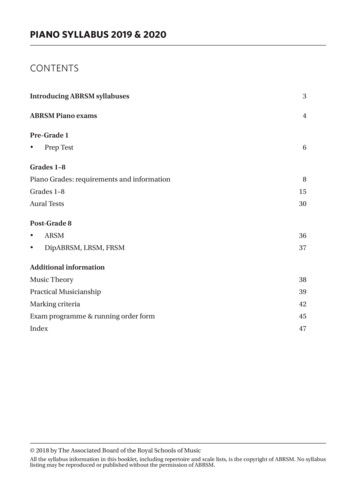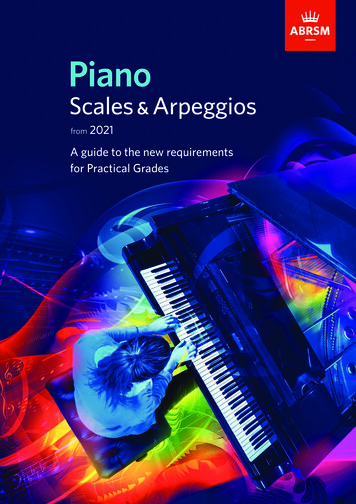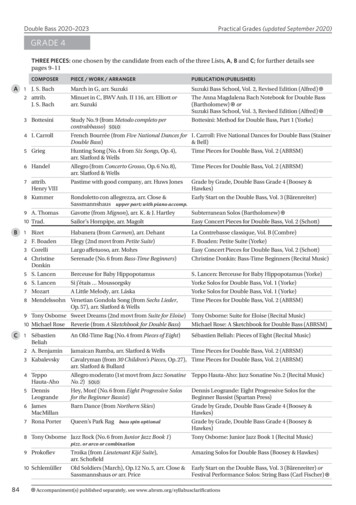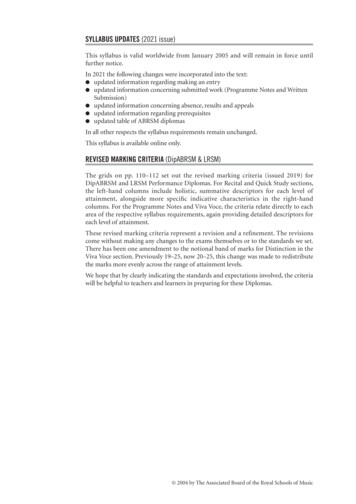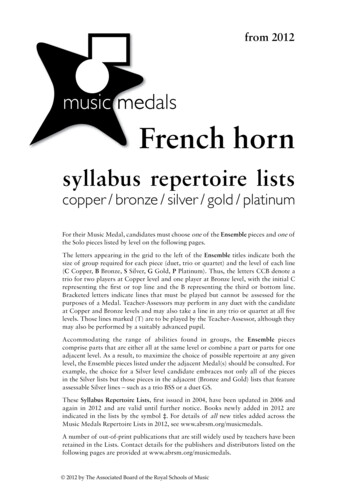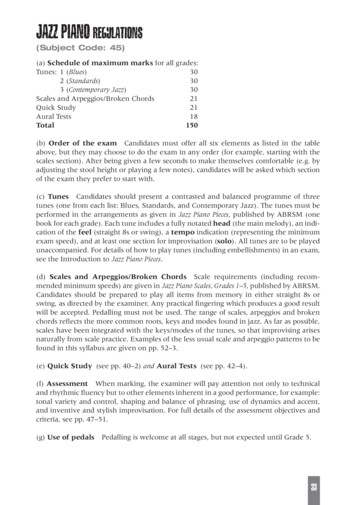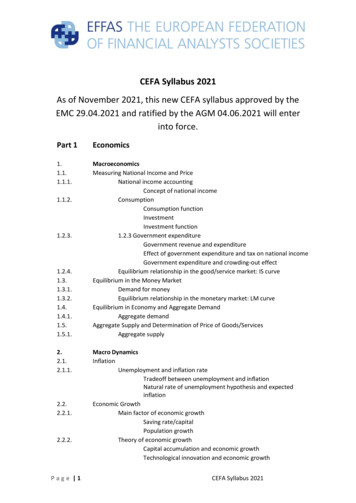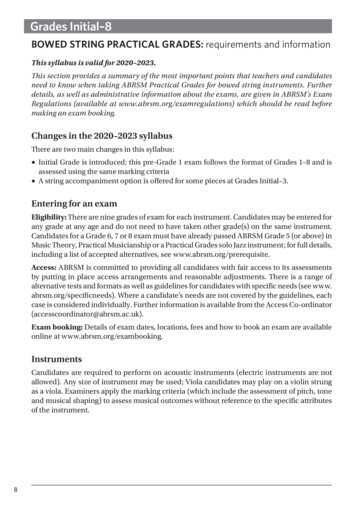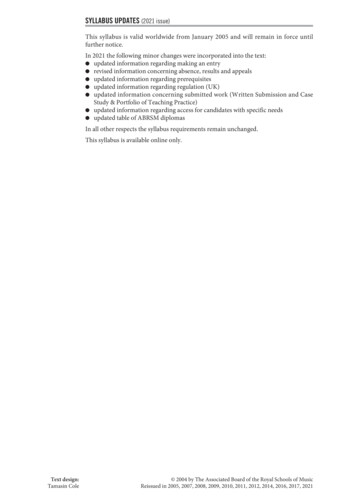
Transcription
SYLLABUS UPDATES (2021 issue)This syllabus is valid worldwide from January 2005 and will remain in force untilfurther notice.In 2021 the following minor changes were incorporated into the text:updated information regarding making an entryrevised information concerning absence, results and appealsupdated information regarding prerequisitesupdated information regarding regulation (UK)updated information concerning submitted work (Written Submission and CaseStudy & Portfolio of Teaching Practice) updated information regarding access for candidates with specific needs updated table of ABRSM diplomas In all other respects the syllabus requirements remain unchanged.This syllabus is available online only.Text design:Tamasin Cole 2004 by The Associated Board of the Royal Schools of MusicReissued in 2005, 2007, 2008, 2009, 2010, 2011, 2012, 2014, 2016, 2017, 2021
CONTENTS3 INTRODUCTION67121620CONTENT OF THE INSTRUMENTAL/VOCAL TEACHING DIPLOMASOverviewDipABRSM (Principles of Instrumental/Vocal Teaching)LRSM (Instrumental/Vocal Teaching)FRSM (Music Education)Summary of skills, knowledge and understanding at all levelsPREREQUISITES AND SUBSTITUTIONS22 Prerequisites and substitutions24 Appropriate professional experience25 Substitutions for requirementsSUBMISSIONS28 General information regarding submissions29 Written Submission32 Case Study Portfolio & Video of Teaching Practice (LRSM only)36373839PRACTICALITIESBefore the exam (Entry)On the day of the examAfter the examOther mattersREPERTOIRE LIST42 Compulsory repertoire for FRSM Teaching Skills Viva Voce46586466APPENDICESAppendix 1: Specimen questions and indicative responsesAppendix 2: Marking criteriaAppendix 3: Application form for appropriate professional experience approvalAppendix 4: Regulation (UK)67 INDEX
3INTRODUCTIONABRSM’s diplomas provide an authoritative assessment framework for a wide range ofmusicians – teachers, performers and directors. Whether you are intending to pursue acareer in music, are currently working as a professional and wish to broaden yourqualifications, or are purely after the satisfaction of achieving a personal goal, you willfind that one of our diplomas is right for you.There are three diploma subject-lines – Instrumental/Vocal Teaching, MusicPerformance, and Music Direction. Each subject-line has three levels of award:DipABRSMLRSMFRSMDiploma of The Associated Board of the Royal Schools of MusicLicentiate of the Royal Schools of MusicFellowship of the Royal Schools of MusicThe requirements within each subject-line at each level are generally comparable,and the syllabus for each subject-line is available separately (online only atwww.abrsm.org/diplomas).We also offer the ARSM (Associate of the Royal Schools of Music), a performance-onlydiploma which bridges the gap between Grade 8 and DipABRSM. The ARSM isindependent of the above suite of diplomas and the syllabus is available online atwww.abrsm.org/diplomas.Encouraging diverse approaches to the teaching, performing and directing of music,the diplomas stimulate enjoyment and achievement through the progressiveacquisition of skills, knowledge and understanding. As a result, their usefulness hasbeen acknowledged by music services and agencies around the world. They arecompatible with systems of assessment widely applied in higher education andencourage lifelong learning, without restrictions on length of study or the requirementthat you, the candidate, are taught in an institution. They are regulated in variouscountries worldwide.The Instrumental/Vocal Teaching diplomas are designed for candidates who areintending to take up, or have already embarked upon, the teaching of an instrument orinstruments. (Throughout this syllabus, the terms ‘instrument’ and ‘instrumentalteacher’ are used to include ‘voice’ and ‘voice teacher’.) While the assessmentcomponents (especially at LRSM and FRSM levels) include educational theory andphilosophy, curriculum studies and aspects of educational administration, the focusthroughout this subject-line is the teaching of music as a practical activity.Consequently, you are required to demonstrate your own performance competence(although the expected level is not as high as that required of candidates taking thediplomas in Music Performance). While most of the exam will normally focus on aspecified demonstration level, the examiners may also discuss matters relating toteaching up to that level, including beginners.At each level of diploma, your skills as an instrumental teacher – of individuals and/orgroups – are explored and assessed in increasing depth. The DipABRSM (Principlesof Instrumental/Vocal Teaching) assesses your knowledge and understanding of theteaching of your chosen instrument. While you are required to demonstrate yourknowledge to the examiners in a clear and communicative way, it is your grasp of theprinciples of teaching your instrument up to and including ABRSM Grade 6 level,rather than your ability to apply them with pupils, that forms the basis of assessment.DipABRSM candidates are not required to have taught and therefore examiners willnot ask you about any personal teaching experiences, although you may volunteerinformation if you have taught.
4IntroductionThe LRSM (Instrumental/Vocal Teaching) calls for a practical application of yourknowledge and understanding of teaching pupils up to and including ABRSM Grade 8level. Key components in this are the preparation of a Case Study Portfolio detailingyour work with pupils as well as the submission of a Video of Teaching Practice. At thislevel, the emphasis is on the skills and ‘business’ of teaching, and elements such aslesson-planning, tailoring approaches to accommodate different learning styles,assessment and pupil motivation are featured. It is the effectiveness and flexibility ofyour personal approach, and the quality of your ability to demonstrate how to engageand motivate pupils, that form the basis of assessment.The FRSM (Music Education) requires you to apply higher-level academic skills toaspects of music education and to give a practical demonstration that you have theappropriate skills, knowledge and understanding to teach students studying repertoireup to and including DipABRSM level. Perceptive critical thought in relation toyour chosen area of research, coupled with knowledge and understanding of theinterpretation of advanced repertoire and the ability to analyse and demonstrate thetechniques required to perform it, represent the basis of this qualification, togetherwith personal insights into the art of teaching.In order to establish basic levels of competence, a specific prerequisite is requiredbefore entry can be made to any level. However, in line with our aim to provide openaccess and to recognize your achievements, we offer a range of substitutions for theseprerequisites, including your previous learning and experience. You are also allowed tosubstitute one of the diploma requirements. The prerequisites and all possiblesubstitutions are listed in the tables on pp. 22–23 and 25. They are also to be found onour website (www.abrsm.org/diplomas), where any substitutions appearing after theissue of this syllabus will also be listed. We hope that you find the experience of takingone of our diplomas stimulating, challenging and worthwhile, both during the periodof preparation and in the exam itself.
6 Overview7 DipABRSM (Principles of Instrumental/Vocal Teaching)12 LRSM (Instrumental/Vocal Teaching)16 FRSM (Music Education)20 Summary of skills, knowledge and understanding at all levelsDIPLOMA CONTENTCONTENT OF THEINSTRUMENTAL/VOCALTEACHING DIPLOMAS
6OVERVIEWDIPLOMA CONTENTOverviewThe Instrumental/Vocal Teaching diplomas are available both to instrumental andvocal teachers and to those wishing to become teachers. Through live and writtencomponents, you, the candidate, will be examined in your approaches to teaching yourinstrument/voice, your competence as a performer and your understanding of idiomand repertoire. The diplomas are conducted in English (see p. 39).Before you can enter for a Teaching diploma, you will need to show that you fulfil aspecific ABRSM prerequisite as evidence that you have reached a required minimumlevel of competence. The table on pp. 22–23 lists the prerequisites and their possiblesubstitutions.Each level of diploma comprises a number of requirements that you must satisfyin full. The requirements are divided into two sections, as outlined below. You mustpass all the requirements of both sections in order for your diploma to be awarded.The requirements must be met in full within three years. The table on p. 25 lists thepossible substitutions for requirements.SECTION 1 a Teaching Skills Viva Voce, entailing a discussion with the examiners andincluding demonstrations of teaching approaches. At LRSM level, the TeachingSkills Viva Voce includes discussion of a Case Study Portfolio and a Video ofTeaching Practice, which together must have been submitted for assessment andawarded a pass by ABRSM before you can proceed with the rest of your diploma(see p. 32).SECTION 2 Section 2.1 a Written Submission, which you should be prepared to discuss as part of yourTeaching Skills Viva Voce.Section 2.2 a Quick Study – performance of a short piece of unaccompanied and previouslyunseen music.Full descriptions of each level of diploma, including preparation guidance, are given onthe following pages. All practical information about taking a diploma is described inPracticalities (pp. 36–40).
DipABRSM General information/Section 1Prerequisites ABRSM Grade 8 (Practical or Performance) in the instrument taught or a permittedsubstitution (see p. 22), and ABRSM Grade 6 Music Theory or a permittedsubstitution. You must be 18 years of age or older at the time of entry and must enclosewith your completed entry form a photocopy of your birth certificate/passportdetails/identity card or other document proving your date of birth.To be submitted A Written Submission on a prescribed topic must be submitted when you enter for thewith your entry diploma. Full details regarding the Written Submission, including length andprescribed topics, are given on pp. 28–31.Timing 60 minutes are allocated to the DipABRSM, including up to 40 minutes for theTeaching Skills Viva Voce and up to 10 minutes for the Quick Study.SECTION 1 TEACHING SKILLS VIVA VOCEThe Teaching Skills Viva Voce is an opportunity for you to demonstrate to theexaminers that you understand the principles of instrumental/vocal teaching and haveconsidered teaching approaches and strategies. Your ability to perform to a setstandard will also be assessed. You will be expected to show your understanding of theidiom of your instrument, and this understanding must be derived from practical, notjust theoretical, experience. You should also be prepared to discuss your WrittenSubmission, and matters arising from it.Teaching materials You should bring a variety of materials for use with pupils, among which should besome of the current ABRSM graded repertoire for your instrument up to and includingGrade 6 level. You should be familiar not only with the repertoire but also with therequirements for each of these grades for your instrument (and the Prep Test, ifapplicable) and should be prepared to discuss issues relating to the teaching of pupilsup to and including Grade 6. A representative sample of the teaching materials youbring with you will be referred to during the Viva Voce.Demonstration In order to demonstrate to the examiners that you are able to perform authoritativelyto students at the level of ABRSM Grade 6, the materials you bring to the exam mustinclude a selection of pieces chosen by you from the current Grade 6 syllabus for yourinstrument. For the majority of instruments you must prepare three pieces, one chosenfrom each of the three lists (Lists A, B and C). If you are a harpsichordist, percussionistor singer you must prepare the following: Harpsichord: three pieces, one chosen from each of Lists B and C and one chosenfrom either List A or D Percussion: three pieces, one chosen from the lists for each of the three instruments(tuned percussion, timpani and snare drum) Singing: three pieces, one chosen from any three of the five lists (Lists A, B, C, Dand E)You will be asked to perform extracts from these pieces, as selected by the examiners,and to discuss teaching and learning issues as they arise. The extracts must beperformed unaccompanied. The examiners may also ask you about your knowledge ofsome of the other pieces in the Grade 6 lists.Equipment A music stand will be provided at ABRSM Public Venues although you are welcome tobring your own if you prefer. A chair/stool will also be provided for those who requireit, e.g. cellists; double bassists should provide their own stool if required. You may notbring any material or equipment unconnected with your exam into the exam room –this includes any device capable of recording. All mobile phones must be switched off.DIPLOMA CONTENTDipABRSM (Principles of Instrumental/Vocal Teaching)7
DipABRSM Section 1DIPLOMA CONTENT8Other requirements Please note that candidates failing to meet the syllabus requirements in any way, suchas not being prepared to perform extracts from the required number of movements/pieces, will be liable to penalty. The making or use of photocopies of copyright materialis not permitted without prior written permission from the publisher/copyright holder.Duration The Teaching Skills Viva Voce lasts up to 40 minutes.Typical areas of discussion in the Teaching Skills Viva Voce: SECTION 1Musical outlook: questions designed to put you at ease and to lead into thediscussion, including: identification of the materials brought to the exam;knowledge of the underlying concepts and principles associated with yourinstrument.Technique: knowledge and understanding of the techniques required to performrepertoire up to and including ABRSM Grade 6, and demonstration of approachesto teaching and performing them at this level, including posture, intonation, scalesand exercises, tone production, articulation and phrasing.Pedagogy: knowledge and understanding of the teaching and learning process,including: appropriate strategies for teaching individuals and (where appropriate)groups, and awareness of different learning styles; lesson planning, content andstructure; assessment issues and reflective practice; teaching musicianship andinstrumental/performance skills; practice; motivation.Written Submission: points of clarification, discussion of the topic chosen and thesources used.Repertoire: knowledge of repertoire for students up to and including ABRSMGrade 6 level, including tutor books, exercises and other teaching resources.Style and interpretation: knowledge and understanding of musical styles and theinterpretation of notation in order to produce stylistically aware performances, aswell as demonstrations of how these can be taught to pupils up to and includingABRSM Grade 6 level.History and background of the instrument/voice: knowledge of the main(construction) features of the instrument/voice and how it has developed over time.Strategies for making pupils familiar with the accompaniment: demonstrationthat you have appropriate strategies for introducing pupils to the complete textureof pieces (does not apply to keyboard, guitar or harp teachers).Professional values and practice: understanding of the legal framework relating toteaching, including child protection, maintaining a safe learning environment, thephysical well-being of pupils, and equal opportunities for all learners.Any further points you wish to draw to the examiners’ attention before theconclusion.PREPARATION GUIDANCE FOR TEACHING SKILLS VIVA VOCEThe ability to communicate both verbally and through musical demonstration is centralto the art of instrumental/vocal teaching. For this reason, the Teaching Skills Viva Voce isthe main mode of assessment in the Teaching diplomas. This type of Viva Voce isdesigned to reflect your understanding of teaching (of individuals and/or groups) and toexplore your ability to teach up to and including a specified level. As well as beingrequired to perform to a set standard, you should be prepared to discuss, defend anddemonstrate your teaching approaches, from beginner level to the specified upper level.Through your demonstrations you are expected to reveal a relevant knowledge ofperformance practice, an understanding of the idiom of your instrument, and an abilityto teach all aspects of the music. Remember that every element of the ABRSM examsmay be drawn into the discussion. It is important to remember, too, that the ABRSMsyllabuses are not a curriculum and that exams should not be an end in themselves.
DipABRSM Section 1Appendix 1 contains a number of specimen questions and indicative responses,showing the types of question examiners might ask in the Teaching Skills Viva Voceand an indication of appropriate responses. There is also a list of recommended textson ABRSM’s website (www.abrsm.org/diploma-preparation).The tone and manner of the Viva Voce will be as relaxed as possible and the examinerswill make every effort to put you at ease. The opening questions will be informal,progressing to topics on which you are likely to be knowledgeable, then on to morechallenging questions. All the questions will be clearly and directly expressed by theexaminers; some will be open-ended, others will be more specific. You will not bepenalized if you ask for clarification of a question, and the examiners will not beconcerned by short periods of silence when an answer is being considered.You may opt not to answer a question because, for example, you feel you mightexpose an area of fundamental ignorance. If this happens, the examiners will assist youwith a number of helpful prompts. They will form a judgement as to whether yourincapacity to offer an answer to a particular question or series of questions is asignificant factor in the assessment of your overall performance in the exam.Throughout, the examiners’ objective is to discover what you know, rather than whatyou don’t know. Successful teaching principles cover a wide spectrum, and there israrely a single definitive strategy to deal with each potential problem. The examinerswill consider and evaluate views and opinions that may not necessarily accord withtheir own feelings and experience. They will not ask questions with only a single ‘right’answer in mind. The opportunity for you to offer additional information will beprovided before the session concludes, so that you are able to give a full account ofyourself. The Quick Study, unless it was performed earlier in the exam, then follows.If you are not fluent in English you are strongly advised to bring an interpreter (seeLanguage and interpreters, p. 39).SECTION 1ADDITIONAL PREPARATION GUIDANCE FOR TEACHING SKILLS VIVA VOCEFOR DipABRSM CANDIDATESThe Teaching Skills Viva Voce at DipABRSM level focuses initially on aspects of teachingin the context of the ABRSM Grade 6 pieces you have chosen. Success in theDipABRSM demands a level of personal performing competence on your part.However, this is not specifically assessed, nor will you be invited to give a formalperformance at any stage. Such playing/singing as takes place should arise from ateaching perspective – above all, the intention is to recreate the teaching situation. Thisis why you are not required to perform your pieces complete, but only extracts chosenDIPLOMA CONTENTYou will be expected to make use of a variety of teaching materials, so do bring copiesof some of your teaching books, in addition to your prepared ABRSM syllabus items, asthe examiners will want to form an impression of the range of publications you use (orexpect to use). As well as inviting you to perform and demonstrate examples from themusic you have brought with you, the examiners may also refer to other ABRSMsyllabus items for your instrument up to and including the specified level in order toamplify discussion and to enable you to reinforce answers to questions. In these cases,an ability to draw upon suitable examples at various levels will be expected, rather thana comprehensive knowledge of all the ABRSM repertoire lists. Discretionary use mightbe made of one of the examiners as a ‘pupil’ (though your instrument will not behandled by the examiner in any circumstances). You should therefore be prepared toact as teacher to one of the examiners. The Viva Voce will also draw on your WrittenSubmission and there will be the opportunity for you to talk about teaching strategiesand learning styles. The examiners will be looking for a practical and personalapproach to teaching.9
DIPLOMA CONTENT10DipABRSM Section 1by the examiners as a focus for discussion and to allow you to show that you candemonstrate the repertoire competently to a student. The examiners may interrupt youat the end of a section or stop you to ask to hear a later passage or a section ofanother of your prepared items. All such interruptions will occur when an appropriateteaching element arises.While it is not a requirement of the DipABRSM that you will have had direct experienceof teaching up to and including ABRSM Grade 6 level, sufficient evidence does have tobe demonstrated of your understanding of the principles involved in pupils’development up to this point. Questions will range more widely than the specifics oftechnique, and may include elements that contribute to an enjoyable and fruitfullesson, such as aural development, sight-reading and improvisation. With theexception of keyboard players, guitarists and harpists, the examiners may also askabout your strategies for making pupils familiar with the full texture of theaccompaniments to their pieces. Remember, however, that you must not bring anaccompanist with you to the exam.In addition, the examiners will focus on performance aspects of your demonstration.The examples below give an indication of the style of questioning that the examinerswill adopt: You maintained the pulse excellently in this bar, but a student might have difficulty.What might well go wrong at this point? What would you suggest as a way ofdealing with this? What are the issues to do with balance here? What pedal technique are you using here, and how would you teach it? How would you encourage good articulation in this passage? What sort of exercise would help a pupil achieve a smooth transition over thebreak in this phrase? This is a difficult vowel sound for a high note – how would you help a studenthere?Further specimen questions, as well as selected indicative responses, are provided onpp. 46–47 and 51–53.In this part of the Viva Voce, the examiners may explore physiological and other aspectsof technique – forearm rotation/finger action, breathing/support, embouchure/alternative fingerings, bow holds/wrist position, etc. Having clearly articulated eachquestion, the examiners will allow you time to provide your full response. They maythen pursue either a further element raised by the same piece or move on to anothertopic. Not all of the examiners’ questions will focus on the instrument, and there willbe the opportunity for you to express broader ideas or to address issues which may ormay not already have arisen.Remember that you are required to bring with you a variety of teaching materials,including your prepared items from the ABRSM syllabus lists for Grade 6, and there willbe opportunities for you to talk about these. The examples below give an indication ofthe types of question that the examiners will ask: What materials have you brought to show us? In what circumstances would youuse this book of exercises/this repertoire? Which of these books might you choose for an adult beginner? How well does the progression of repertoire work in this book? How do you keep up with new teaching material for your instrument?Further specimen questions, as well as selected indicative responses, are provided onpp. 46–47 and 51–53.
DipABRSM Section 210%) on a prescribedYou are required to complete a Written Submission of 1,800 words ( topic. The Submission, and matters arising from it, will be discussed in the Teaching Skills VivaVoce. ABRSM must receive your Submission at the time you make your diploma entry. For fulldetails, including preparation guidance and prescribed topics, see pp. 28–31.SECTION 2.2 QUICK STUDYIn this section of the exam, you are required to perform a short piece of unaccompanied andpreviously unseen music of a standard similar to ABRSM Grade 6 repertoire.Before you perform the Quick Study, you will be given five minutes in which to look throughthe music and to try out any parts of it. During this time the examiners will not be assessingyou. In total, the Quick Study lasts up to 10 minutes.Notes for The Quick Study will be either for tuned percussion or timpani: the examiner will choose thepercussionists test according to the instruments brought to the exam.Notes for The Quick Study tests for singers are printed with a simple piano accompaniment, whichsingers candidates may use if they wish, to any degree of fullness, during their preparation time.During this time, candidates may also play any part of the vocal line at the piano. The actualperformance of the test is unaccompanied, although candidates who need to relocate theirpitch may play a guide note (from the vocal line), as appropriate. Candidates may also use thepiano to play the key-chord and their starting note before performing the test. Examiners willnot assist candidates as accompanist, nor will any other party be permitted to. Candidatesmust sing the text and will be offered a choice of English or Italian words.SECTION 2.2PREPARATION GUIDANCE FOR QUICK STUDYMany candidates choose to perform the Quick Study after the Teaching Skills Viva Voce, but youare at liberty to perform it beforehand, if you prefer. You should inform the examiners of yourpreferred order at the start of the exam.The standard of the Quick Study test piece is similar to the demands of the current repertoire listsfor the indicated ABRSM grade. You will therefore find it helpful to look at the pieces set for yourinstrument at this grade. Since the Quick Study tests have all been composed specifically for thediploma exams, they tend to be in a modern, approachable style, although some of the tests havebeen written in pastiche styles. For keyboard instruments, guitar and harp, the test will normally belaid out over two pages. For all other instruments, the test will normally occupy one page. The testsfor all instruments are unaccompanied (singing candidates: see Notes for singers above).It is not the length of the test but the technical and musical challenges with which you will bepresented that you should concentrate on in preparing for the exam. The marking criteria on p. 63make clear what level of performance is expected for a pass or above in this test. Making it a habitto explore music unknown to you, and treating the exploration as a quick study exercise, will giveyou useful experience for the exam.On the day, make sure you have mentally adjusted before you undertake the test; for example, if youhave chosen to perform the Quick Study after the Teaching Skills Viva Voce, do not allow yourself tothink about aspects of the Viva Voce discussion, such as ideas you omitted to mention or might haveexpressed differently. Using the five minutes’ preparation time to full advantage is vital to your successin the Quick Study. To play through sections that do not need any attention is a waste of valuable time– go straight to the bars that matter. Try to avoid the common mistakes of either playing too slowly inorder to get every note correct, or nervously hurrying and tripping over. Getting just the right tempo toallow the music to ‘speak’ is crucial. And finally, try to project the musical content and style in anexpressive way, communicating the music with your best tone quality.DIPLOMA CONTENTSECTION 2.1 WRITTEN SUBMISSION11
LRSM General information/Section 1DIPLOMA CONTENT12LRSM (Instrumental/Vocal Teaching)Prerequisites DipABRSM (Principles of Instrumental/Vocal Teaching) in the instrument taught or apermitted substitution (see p. 23), and ABRSM Grade 8 Music Theory or a permittedsubstitution. You must be 20 years of age or older at the time of examination and mustenclose with your completed entry form a photocopy of your birth certificate/ passportdetails/identity card or other document proving your date of birth.To be submitted3 months prior tothe publishedclosing datefor entryYou must submit a written Case Study Portfolio describing the progress of three ofyour pupils together with a Video of Teaching Practice showing your work with at leasttwo pupils. These must be submitted to ABRSM with a completed entry form at leastthree months prior to the published closing date for entry and they must have beenawarded a pass before you can proceed with the rest of your diploma (which must betaken during the next exam session). Issues arising from these two submissions will bediscussed in the Teaching Skills Viva Voce. Full details of the Case Study Portfolio andVideo of Teaching Practice are given on pp. 28 and 32–34. Entry details are given onpp. 36–37.To be submittedby the publishedclosing datefor entryA Written Submission on a prescribed topic must be sent to ABRSM. (Please note thatyour Submission must be sent only after you have received confirmation that your CaseStudy Portfolio and Video of Teaching Practice have passed.) Full details regarding theWritten Submission, including length and prescribed topics, are given on pp. 28–31.Timing 75 minutes are allocated to the LRSM, including up to 50 minutes for the TeachingSkills Viva Voce and up to 10 minutes for the Quick Study.SECTION 1 TEACHING SKILLS VIVA VOCEThe Teaching Skills Viva Voce is an opportunity for you to demonstrate to theexaminers
vocal teachers and to those wishing to become teachers. Through live and written components, you, the candidate, will be examined in your approaches to teaching your instrument/voice, your competence as a performer and your understanding of idiom and repertoire. The diplomas are conducted in English (see p. 39).
